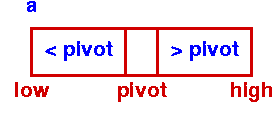|
Data Structures and Algorithms
|
| 7.3 Quick Sort
|
Quicksort is a very efficient sorting algorithm invented by C.A.R. Hoare.
It has two phases:
- the partition phase and
- the sort phase.
As we will see, most of the work is done in the partition phase -
it works out where to divide the work.
The sort phase simply sorts the two smaller
problems that are generated in the partition phase.
This makes Quicksort a good example of the
divide and conquer
strategy for solving problems.
(You've already seen an example of this approach in the
binary search procedure.)
In quicksort, we divide the array of items to be sorted into
two partitions and then call the quicksort procedure recursively
to sort the two partitions,
ie we divide the problem into two smaller ones and
conquer by solving the smaller ones.
Thus the conquer part of the quicksort routine looks like this:
quicksort( void *a, int low, int high )
{
int pivot;
/* Termination condition! */
if ( high > low )
{
pivot = partition( a, low, high );
quicksort( a, low, pivot-1 );
quicksort( a, pivot+1, high );
}
}
|

Initial Step - First Partition |

Sort Left Partition in the same way |
For the strategy to be effective, the partition phase
must ensure that all the items in one part (the lower part) and less than
all those in the other (upper) part.
To do this, we choose a pivot element and arrange that all the
items in the lower part are less than the pivot and all those in the
upper part greater than it.
In the most general case, we don't know anything about the items to be
sorted, so that any choice of the pivot element will do -
the first element is a convenient one.
As an illustration of this idea,
you can view this animation,
which shows a partition algorithm in which items to be sorted
are copied from the original array to a new one:
items smaller than the pivot are placed to the left
of the new array and items greater than the pivot
are placed on the right. In the final step, the
pivot is dropped into the remaining slot in the middle.
QuickSort Animation
This animation was based on a suggestion
made by Jeff Rohl;
it was written by Woi Ang. |
|
Observe that the animation uses two arrays for the items being
sorted:
thus it requires O(n) additional space
to operate.
However, it's possible to partition the array
in place.
The next page shows a conventional implementation of the
partition phase which swaps elements in the same array
and thus avoids using extra space.
- Divide and Conquer Algorithms
- Algorithms that solve (conquer) problems by dividing them into
smaller sub-problems until the problem is so small that it is
trivially solved.
- in place
- In place sorting algorithms don't require additional temporary
space to store elements as they sort;
they use the space originally occupied by the elements.
©  , 1998
, 1998


 , 1998
, 1998